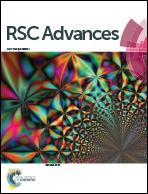Grafting of multi-sensitive PDMAEMA brushes onto carbon nanotubes by ATNRC: tunable thickening/thinning and self-assembly behaviors in aqueous solutions†
Abstract
Well-defined modification of multi-wall carbon nanotubes (MWNTs) with different molecular weight poly(2-(dimethylamino)ethyl methacrylate) (PDMAEMA) was high-efficiently realized by atom transfer nitroxide radical coupling (ATNRC), which was confirmed by 1H NMR, TEM and thermogravimetric analyses (TGA). The multi-responsive behaviors of PDMAEMA modified MWNTs (MWNTs-g-PDMAEMA) suspensions were systematically investigated by rheology. Reversible thermo-thickening behavior was detected in MWNTs-g-PDMAEMA suspensions, attributing that PDMAEMA side chains aggregated to hydrophobic micro-domains physically cross-linking the polymer chains at temperatures above LCST. By the incorporation of sufficient free PDMAEMA chains (f-PDMAEMA), the suspensions with enough long grafted-chains exhibited obvious shear-thickening behaviors at high pH, which was absent in the suspensions with short grafted-chains due to steric hindrance of MWNTs as backbones. The primary mechanism of shear thickening was ascribed to the shear-induced transformation of intra-chain cross-linking to inter-chain cross-linking induced by the bridging effect of additional free-chains. Hydrophobic interaction, the amount of f-PDMAEMA chains and grafted-chain length were determined as the three vital factors of shear-thickening behaviours, which could be employed to fulfill tunable thickening/thinning responsive of MWNTs-g-PDMAEMA. In the study of self-assembly properties of MWNTs-g-PDMAEMA and the hybrid system of Au nanoparticles immobilized MWNTs-g-PDMAEMA dilute aqueous suspensions, typically dendritic fractal patterns with different details were formed in response to pH values and the concentration of NaCl, which have not been reported in the literature yet. The morphology of the self-assembled hybrid systems of Au nanoparticle immobilized MWNTs-g-PDMAEMA aggregates gradually transformed from rigid, straight and wide trunks with few side branches to soft, bent and slim trunks with many side branches as the pH value increased. The insights reported here can help to deeply understand the thickening/thinning essence and self-assembly principle of polymer brush grafted MWNTs suspensions, and guide the development of complex responsive materials with better performance.


 Please wait while we load your content...
Please wait while we load your content...